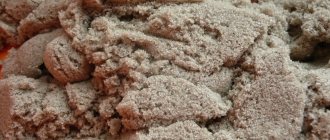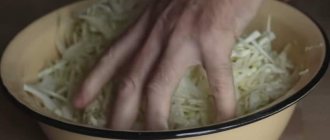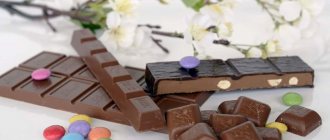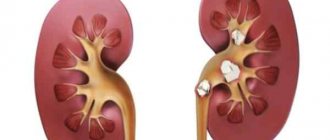No matter the variety of modern toys, children are still drawn to the sandbox. So far, stucco molding of Easter cakes and building castles are not in competition. But what to do if the play area in the courtyard of a high-rise building is not the cleanest place? Either the rain will wet it, or the wind will throw leaves and debris, or four-legged friends will make a place to sleep in it. If in a private house you can install your own playground, then for children in apartments they came up with an innovation - kinetic sand. Yes, yes, you understood correctly: you can play with it right in your room on the floor. Fantastic, isn't it?
What is kinetic sand?
The innovative molding material was developed by scientists from Sweden. It is designed for organizing children's games based on the principle of a home sandbox. Unlike street counterparts, the material does not stain the child’s clothes. In addition, parents drew attention to kinetic sand as an opportunity for children to express limitless creative imagination. The child spends time with great pleasure, fashioning figures and even entire castles from it.
What does kinetic sand look like?
Modern molding material has increased plasticity and can be of different colors. Externally, the kineticist resembles ordinary sand, the particles of which are bound by a special polymer. It prevents the grains from scattering and easily collects them into a homogeneous mass. The combination of plasticity and fluidity of kinetic sand helps to form all kinds of crafts from it, which are then very easy to break and put back in the packaging.
Composition of kinetic sand
Experts say that the molding material is absolutely safe. Parents should not worry about the health of the child, who selflessly sculpts figures from him. Here's what kinetic sand is made from:
- purified quartz sand – 98%;
- harmless silicone polymer – 2%.
The latter component can be used as an additive in the food industry. The high quartz content makes kinetic sand porous and viscous. This consistency facilitates the formation of crafts of any complexity. The natural sand color can be easily transformed into any shades thanks to the addition of dyes. For these purposes, manufacturers use only natural substances.
Popular games
You can think of many ways to use such a toy.
Some of them:
- With cookie cutters. You can roll the sand on the table with a roller or rolling pin into a thin layer and “bake” a variety of cookies with your child.
- A competition to see who can build a snowman the fastest. This product behaves quite unusually if you build various figures from it: having made the next level, you will see a fairly stable structure, but as soon as you slightly increase the quantity and weight, it crumbles before your eyes. You can do this: roll three balls at a time and make a snowman out of them. Whose snowman is stronger and lasts longer wins.
- With different accessories. These can be any available items: buttons, beads, bottle caps, ice cream sticks and others. With them you can make interesting animals, decorate castles, and make funny faces. You just need to remove these items at the end of the game so that they don’t interfere later.
- Using a knife with a rounded end. Every mother wants her child to be a helper, especially in the kitchen. So, you can instill in your child the first skills of using a knife. You can roll sausage or make bread from sand, and then make a sandwich out of it.
- Fingerprints or traces. You can take different toys and press them. You will get fairly clear outlines of various objects. You can also have one person make a print, and the other guess what it is.
- Stamps. Kinetic sand is convenient for making prints of numbers and letters. For these purposes, you can use symbols from a magnetic board.
- Letter. You can write the same letters and numbers with your finger or a popsicle stick, it's more fun than on paper.
- Forming cakes and cupcakes. Your kitchen molds for muffins and other baked goods are quite suitable. Children also love to decorate their “baked goods.” You can make a mini-oven from a cardboard box, paint it with paints or markers, and set up a real bakery for your children.
- Modeling letters. It is good for making letters and numbers. This is another opportunity to try to learn counting and the alphabet in addition to - modeling with plasticine with children -
- Sculpting. These can be different structures in the form of castles, highways, bridges, mountains and anything that the imagination of a little inventor can create.
Kinetic sand - benefits for children
Manufacturers have not specified an upper limit for the use of the material, because the toy is suitable for children, teenagers and even adults. Kinetic helps to develop imagination and self-expression. This is an excellent anti-stress remedy for adults. In addition, the molding material is not hazardous to health. The main thing is to ensure that small children do not swallow large pieces of it. What kinetic sand develops in a child can be judged by its useful functions:
- develops fine motor skills;
- teaches creativity;
- harmonizes emotional state;
- develops tactile sensitivity.
Pros and cons of kinetic sand
Children love to spend time making figures and building castles. The texture is pleasant to the touch and makes playing with kinetic sand fun. The hypoallergenic composition and safety for children are considered the most important advantages of the material. It has other advantages:
- Any kinetic sand for modeling does not dry out for a long time. Its shelf life is 3 years, but in practice it may be longer. During this period, the ductility and plasticity of the material is maintained.
- The constituent components of kinetic sand are not a favorable environment for the development and spread of bacteria.
- The multi-colored material does not require special storage conditions and does not dry out when exposed to the open air for a long time.
- Contaminated kinetic sand can be washed. Exposure to moisture does not affect the integral structure of the molding material.
- Scattered kinetic particles are easily collected using a lump of sand. It has a magnetic effect and quickly restores order on the work surface.
The disadvantages of kinetic sand are associated with some of its properties:
- Chemical smell
. When unpacking the product, you may notice an unpleasant odor, which gradually dissipates. - Increased density
. Compared to its natural counterpart, kinetic sand is not very free-flowing. This may limit the realization of the child's creative imagination. - Poor ability to maintain shape
. It is difficult to fashion a large-scale project out of a kineticist. The large figure will begin to blur and quickly lose its shape.
Magic in your hands: What kinetic sand can do
At first glance, it is no different from the usual one. But as soon as you pick it up, it becomes clear: something is wrong here. In fact, the material is 98% quartz sand. 2% belongs to a silicone bond, which gives it unique properties. When sifting, kinetic grains of sand try to separate, but under the influence of the polymer, on the contrary, they are attracted to each other and form threads up to 2 mm long. Thanks to this feature, kinetic sand flows from your hands like a stream of water. It feels wet to the touch, but does not dry out over time. The result is endless exciting games with the same set.
Advantages of kinetic sand:
- 100% safe - does not contain toxic substances
- 100% hypoallergenic - suitable for children susceptible to allergens
- prevents the development of microorganisms
- has 3 properties at once: friability, pliability and fluffy consistency
- allows you to sculpt a variety of figures without the use of water
- does not stain hands, clothes, furniture and carpets
- works best together with molds
- kinetic sand that ends up on the floor will not scatter, but will remain in the form of a viscous mass
- does not get into the eyes and does not cause a burning sensation
- Easy to clean - just roll it into a ball until the next game
- soft porous material allows you to build castles that hold their shape well for a long time
- In addition to modeling, kinetic material is also suitable for drawing; It’s easy to draw simple pictures on it
- develops logic, tactile sensations, creativity, fine motor skills
- used by many psychologists to treat mental disorders, combat phobias and stabilize emotional background
- calms hyperactive and aggressive children
- effective for children with speech delays.
Which kinetic sand is best?
There are also differences among creative materials. You can choose the best kinetic sand by knowing its main characteristics. It is produced in different countries, so the names of analogues are different. Manufacturers divide molding sand into:
- Kinetic, resistant to the external environment and moisture
. It has a wide color palette and plastic consistency. Stored in a closed container. - Space sand
with similar kinetic characteristics. It is cheaper because it is produced by Russian companies. Has an unlimited shelf life if properly stored. - Living sand
, which contains aromatic oils and crushed shell rock. It only comes in white color and can dissolve in water. The material is stored in an open container.
Kinetic sand rating
The high demand for molding material causes a large number of offers. Toy stores offer a wide selection of kinetic sand. Before purchasing, it would be a good idea to read reviews from parents about a particular brand. The TOP 3 according to buyers includes:
- Kinetic Sand
from a Swiss manufacturer. The product is presented in containers of different sizes and has a wide palette of shades. The children's creativity set includes molds and spatulas. - Space sand from a Russian manufacturer
. Like its foreign counterpart, the domestic creative material is distinguished by its bright colors and good plasticity. You can select a container of the desired size. Molds, figures and spatulas are included. - Kinetic sand Sands Alive
from a Korean manufacturer. The material contains aromatic oils and shell particles. Sand is light and comes only in white.
Which sand do you prefer?
How to choose kinetic sand? In principle, all commercially available materials have similar qualities and differ little in properties. Still, it’s worth considering popular brands and their features:
- The signature sand of the Swedish brand “Kinetic Sand” was the first and for some time the only one, and it pleases with a wide range and configuration. The series contains materials of different colors (including bright and even shimmering), and in the packaging you can find presses, storage containers, molds, and stamps. In addition, there are special sets, such as “Ice cream parlor”, “Construction site”, “Car park”.
- Cosmic plastic sand (Russia) has the same characteristics, but has a more affordable price. You can find several colors on sale, and kits for children's creativity with molds included are also sold.
- The Russian-made “Home Sandbox Lori” also has a lower price than the Swedish brand, but otherwise everything is almost the same: different shades, molds included. In addition, you can find a set with an inflatable sandbox and shovels. Multi-colored “rainbow” sand is packaged in separate small containers.
- “Angel Sand” is produced in South Korea and is slightly different from other brands in its composition, which contains fine mineral sand instead of quartz sand. This is reflected in the texture: it is very airy, light, and rather resembles flour rather than the usual sand. But the shape is maintained well.
For your information! Each brand offers packs of different sizes, usually from 1 kilogram to 5.
Sandbox for kinetic sand
After playing and practicing with creative materials, there is no dirt or scattered particles left. Manufacturers recommend purchasing or making your own a wide box for placing kinetic sand. A home sandbox will help keep all the kinetics in one place, which will be convenient for the child and his parents. You can find a wide range of boxes in stores. An inflatable sandbox for kinetic sand is popular. It doesn't take up much space when assembled, so after games you can put it away in the closet.
Molds for kinetic sand
Crafts made from creative materials are varied. To make them, your child will need special molds. The kinetic sand kit includes a shovel and stencils. Creative molds depict:
- marine life;
- animals;
- birds;
- fairy-tale characters;
- stars
- building;
- geometric figures.
How to use?
What is kinetic sand used for? For games, development, creativity, learning and just a pleasant and useful pastime. You can make different figures, build, compare the sizes of formed elements, draw in the sand, leave marks with stamps, cut out elements with a safety knife, or even learn to use cutlery and master culinary skills.
Kinetic sand is suitable for children over three years old, as children can taste the material or put it in their nose, which is undesirable and even dangerous if inhaled. As for the optimal volume, it depends on the age of the child and the characteristics of the activity. So, 1-1.5 kg will be enough for a three-year-old, but an older child will need much more, especially if he plans to start a large-scale construction project.
It is quite possible to store the material in normal room conditions at an average level of humidity (45-60%). It is better to put it in a container and close the container to prevent spillage and the entry of foreign substances or odors. Also limit access to small children and pets. Storage periods are not limited by manufacturers.
And finally, a few rules for using amazing kinetic sand:
- If wet, spread the material in an even thin layer and leave it to dry for a while. There is no need to use a heater or hair dryer.
- If the kinetic sand becomes dry (due to heat or low humidity levels, for example), either spray it with a small amount of water or wet your hands and rub the material in them. There is no need to pour water.
- Before classes, it is advisable to wash your hands so as not to stain the material or transfer foreign odors to it.
- It is better to exercise in tight-fitting and smooth clothes to which the material will not stick. A girl should wear her hair in a ponytail or bun.
- After games, carefully collect sand to avoid reducing its volume.
- Do not add foreign substances as they may impair plasticity.
Be sure to try playing with kinetic sand with your child. It's interesting and useful!
How to make kinetic sand?
On the Internet you can find recipes for making plastic and bright materials for creativity. Experts do not recommend making kinetic sand with your own hands. Such material can be dangerous for games and creative activities. The components that make up homemade sand cause allergies in the child. Those interested can experiment. Ingredients for the homemade mixture:
- sand;
- silicate glue;
- liquid soap or shampoo;
- shaving foam.
The safest recipe:
- Take 1 tbsp. potato starch.
- Mix with 300 g of sand.
- Stir the mixture with 2/3 tbsp. water.
- Add coloring as desired. You can make sand from other ingredients.
Useful tips
- The ideal storage conditions for kinetic sand are cool air and humidity not exceeding 60%.
- If the room is cool and dry, the polymer inside becomes tight and the product takes on a more viscous form.
- The name “Kinetic Sand” is patented only by the two above-mentioned Swedish companies. They are the ones who guarantee the high quality and safety of the product and can provide all copies of certificates, certified by a seal, to you personally upon request.
- If a child has eaten kinetic sand, it is advised to give him a glass of water. Since the original product contains 98% silicon dioxide, it is practically safe for the baby. Of course, this advice does not apply to counterfeit products from unknown manufacturers.
- One-year-old children should not be left alone to have fun; they can eat quite a large amount of this substance, because such babies still continue to try the world “by tooth.”
How to work with kinetic sand?
There are a lot of creative and educational games using molding materials. They differ in purpose and method of implementation. Colored kinetic sand is an excellent tool for developing the creative abilities of a child of any age. The material is also used for educational games. Children's kinetic sand also helps in the treatment of psychosomatic diseases. Working with the material corrects impaired fine motor skills of the hands. There are rules for using this toy:
- store in a closed container;
- play with sand only on a clean and dry surface;
- Do not give to children under 3 years of age;
- keep in a dry and dark place.
What can be made from kinetic sand?
Manufacturers, child psychologists and parents have come up with many games using the innovative substance. You can use kinetic sand for children like this:
- Ask your child to bury treasures in it, and then look for them together. The winner is the one who finds hidden pebbles and small toys faster. This will help develop the child’s attention and increase the speed of his reactions.
- Invite your child to distribute the kinetic sand into molds and then put it in a common container. This accustoms the little person to order and promotes the development of fine motor skills.
- Build a small castle or fortress with your child using small elements. For example, place it on a tower building. This will help develop perseverance and attention to detail.
- Create animal figures with your child and discuss what sounds they make, where they live and what they eat. This promotes intellectual development and increases the baby’s mental abilities.
- Teach your child to reproduce the tracks of different animals in the sand. You can have a competition to see who can guess whose they are the fastest. This will increase the baby’s interest in learning and develop creative abilities.
Advantages and disadvantages
Let's consider all the advantages of kinetic sand:
- Such material does not contain dangerous pathogenic microorganisms that can live in a sandbox with ordinary sand or, for example, on the shore of a reservoir. Initially, it is practically sterile.
- The sand never dries out and even after prolonged active use remains the same plastic and slightly damp to the touch.
- The material is completely safe. Firstly, it cannot be a source of infections, unlike ordinary sand. Secondly, it contains harmless components that, even if accidentally put into the mouth or swallowed in small quantities, will not harm the child’s health.
- Ease of use. Sculpting from such amazing sand is a sheer pleasure, because it is pleasant to the touch, has a light texture, takes any shape, does not stain surrounding objects, does not crumble and does not stick to hands and clothes.
- The classes are not only exciting and fun, but also useful. Games involve fine motor skills and stimulate the development of the speech center, develop creativity and imagination, help learn to focus and concentrate, relieve stress and hyperactivity, and improve tactile sensations.
- Variety of activities. You can come up with many fun games, including educational, creative and educational ones.
- Long service life. Unlike ordinary toys, which can quickly break and fail, kinetic sand retains all its original characteristics.
- Easy to use, practical. After playing, simply remove the material into a container and close the container tightly. If the sand becomes dirty, it is possible to wash the sand, and it dries quickly and under normal conditions, and getting wet does not affect the quality in any way.
The disadvantages are few:
- An unpleasant odor emanating from the material and having notes of glue or vinegar. It is not very sharp and is present in the first days, then fades away and disappears completely.
- The material is not suitable for some games that involve pouring sand or sifting it. It is not free-flowing.
- If you sculpt a large figure, it is unlikely to hold its shape.
- The sand will stick to the silicone molds. And if you step on it, it will stick to the sole of your shoe.
- The price may seem quite high, especially considering the small actual volume of material. Its density is high, so it seems that there is not much sand in the package.
How to store kinetic sand?
The innovative material has a long shelf life. The molding substance is not afraid of direct sunlight, exposure to open air or low temperatures. However, in order for kinetic sand at home to please the owner for a long time with its plasticity and ductility, storage rules must be followed. Basic moments:
- Wash your hands thoroughly before using the material. The silicone component in Kinetics perfectly absorbs various odors and retains them for a long time.
- Close the container containing the sand tightly. This will prevent the material from being affected by the environment. Small particles of dust or other debris will not get into it.
- Make sure that kinetic sand is not accessible to children under 3 years of age or to pets. Do not allow particles or pieces of material to be swallowed.
Where can I buy
Kinetic sand is still a new product on the baby market in our country. Not every store, even one specializing in the sale of educational games, can buy kinetic sand. It happens that sellers themselves do not know and have never heard of such a thing.
The best option is to order unusual sand from an online store. There you can choose different packaging weights of 1, 2.5 or 5 kg. In addition, special molds or a sandbox for use at home are included in the set or separately.
How to restore kinetic sand?
Under the right conditions of storage and use of the molding material, its shelf life may not be limited. However, situations arise when kinetic sand loses its properties and needs to be restored. In this case, there are ways to restore its performance:
- If liquid gets into the sand, it can disrupt its plasticity, so it is necessary to dry the material. In this case, the kineticist must not be subjected to thermal effects. It is simply dried at room temperature in an open container.
- Drying of the molding material leads to loss of viscous properties. You don’t need to think long about how to soften kinetic sand. It is simply kneaded thoroughly with hands moistened with water.
- The sand's loss of brightness makes the crafts not very attractive. However, in this case there is no need to add dye. Tinting substances make the color of the sand mass unattractive. In this case, it is better to purchase new creative material.










